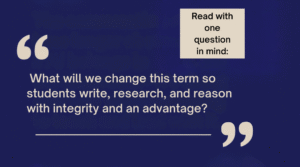AI now runs through campus life: the tools students write with, the systems faculty rely on, and the way colleges operate. This summary covers four moves: GPT-5 becoming an everyday tool, California’s push for AI training across public systems, UNESCO’s call for clear AI competencies, and the NSF’s backing of graduate training tied to workplace needs. You’ll also see campuses taking action with ChatGPT Edu, trustworthy assistants, stronger cybersecurity, and practical faculty development. Read with one question in mind: what will we change this term in our courses, policies, and mentoring so students write, research, and reason with integrity and an advantage?

- California expands AI training across public systems
- 57M U.S. adults seeking AI skills
- UNESCO urges AI competency standards in higher ed
OpenAI’s GPT-5 rolls out; ChatGPT Edu support lands this week
OpenAI has released GPT-5, featuring stronger reasoning and writing performance, and confirmed its availability for ChatGPT Edu/Enterprise starting August 14. Microsoft says GPT-5 is already live in Copilot and Copilot Studio, making rapid campus exposure likely (OpenAI, 2025; Microsoft, 2025).
The Details
- GPT-5 replaces prior default ChatGPT models; Edu/Enterprise rollout set for Aug 14 with higher usage limits.
- Copilot gains access to GPT-5 across platforms; Copilot Studio enables institutions to select GPT-5 for custom agents.
Why it matters
Campus policies, assignment design, and research workflow guidance require immediate updates to accommodate AI-assisted writing, coding, and data analysis as GPT-5 becomes the default across common tools.
Try this now: Add a one-sentence AI use and disclosure line to your syllabus and book a 45-minute GPT-5 sandbox session for faculty this week.
California launches statewide partnerships with Big Tech to expand AI training across public colleges
California announced a multi-year initiative with Google, Microsoft, IBM, and Adobe to provide AI learning tools and training to over two million students across California State University (CSU), community colleges, and high schools, with no new state cost detailed in the release (Office of the Governor of California, 2025).
The Details
- Focus: AI literacy, curriculum supports, and access to vendor programs across public systems.
- Framed as workforce preparation, it aligns with earlier state AI initiatives.
Why it matters
A large, statewide effort sets expectations for faculty development, policy alignment, and academic-writing integrity at scale, especially in high-enrollment, teaching-focused institutions.
Try this now: Hold a 30-minute faculty huddle to choose one shared AI policy line and one sample assignment update, then apply both in every section next week.
UNESCO IESALC flags urgent need for AI competency standards in higher education
A new UNESCO IESALC working paper argues that universities should adopt explicit AI competency standards to align curricula with an AI-integrated society, highlighting risks of fragmented, tool-only approaches (UNESCO IESALC, 2025).
The Details
- Emphasizes transparent disclosure, ethics/bias awareness, and assessment redesign.
- Calls for policy and curriculum coherence across departments.
Why it matters
Backed by an intergovernmental body, this provides institutions with the necessary cover to transition from pilots to policy and faculty training, supporting campus-wide development that integrates writing instruction, research integrity, and AI literacy under shared standards.
Try this now: Draft a simple three-column AI competency map; disclosure and ethics, research and evaluation, writing with AI, and align one assignment to it.
Report: Universities are far below learner demand for AI skills
A Times Higher Education piece, drawing on Validated Insights data, estimates that ~57 million U.S. learners are interested in AI upskilling, but only around 7,000 are pursuing it through credit-bearing higher education programs—most are learning independently or on commercial platforms (Jack, 2025).
The Details
- The availability of AI degree/program remains limited (1–5% of institutions by level), despite rapid enrollment growth in select programs.
Why it matters
The gap suggests immediate opportunities for stackable credentials and faculty development to align curricula with workforce needs while preserving academic rigor in writing-intensive courses.
Try this now: Propose a stackable one-credit micro-credential or add a two-week AI skills module with clear outcomes, process evidence, and quick checks.
Other Stories Making News
More to Scan
- UPCEA: AI is now non-negotiable for marketing & enrollment (UPCEA, 2025)
- Study: Student trust in AI rises with clear, faculty-led policies (Sajja et al., 2025)
- Indiana University rolls out “GenAI 101” campuswide (Indiana University, 2025)
- University of Mary Washington opens Center for AI and the Liberal Arts (University of Mary Washington, 2025)
- NSF funds $45M for 15 new NRT traineeships (NSF, 2025)
- Universities use AI to fill security operations center staffing gaps (Jackson, 2025)
- Cedarville University announces campus-wide ChatGPT Edu deployment (Cedarville University, 2025)
- Howard University partners with AWS on ML educator bootcamp (Howard University, 2025)
- Open-source “AI-University” aligns AI explanations to course content (Faghih Shojaei et al., 2025)
- UMBC offers free 2025 AI learning seminars for faculty and staff (UMBC, 2025)
- University of New Mexico joins Brown-led ARIA institute on trustworthy assistants (University of New Mexico, 2025)
- City Colleges of Chicago expands faculty AI integration with Amazon MLU-EEP (City Colleges of Chicago, 2025)
What to Act on This Week
- Grants and traineeships: Identify one funder or national agency with AI education support and hold a 20-minute huddle to shortlist a fit.
- Campus AI assistants: If your institution provides an approved assistant, post a syllabus policy template and run a 10-minute demo; if not, share your policy and a simple disclosure example.
- Cyber readiness: Schedule a tabletop with IT to walk through alert triage and add a basic cyber hygiene checklist to one course.
- Faculty upskilling: Pick a free, reputable faculty AI course or MOOC and embed one lab or activity in a course this term.
- Trustworthy use: Add a reliability check to one assignment: students name the model used, note limits, and cite sources they cross-checked.
- Events: Register your team for one free AI-in-higher-ed webinar this month and assign a short reflection.
Betting on Purposeful Readiness
If there’s a through line across these stories, it’s this: readiness beats rhetoric. Let’s bet on clear policies, faculty-first training, trustworthy systems, and measurable learning outcomes. Update syllabi and disclosure norms, match courses to an AI competency map, secure the infrastructure, and provide faculty with the time and tools to practice—then track what students actually learn and where they struggle. Taking small, consistent steps now will pay off in stronger teaching, cleaner research, and graduates who are well-prepared for the work ahead.
With Inspiration Moments, we share motivational nuggets to empower you to make meaningful choices for a more fulfilling future. Today’s choice is simple: lead with clarity, teach with courage, and build AI practices that honor learning and raise the bar.
Stay mindful, stay focused, and remember that every great change starts with a single step. So, keep thriving and believing that “Life happens for you, not to you, to live your purpose.” Until next time.
Respectfully,
Lynn “Coach” Austin
References
All sources are hyperlinked in-text for immediate access to original publications.

